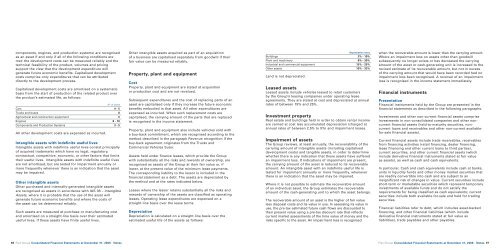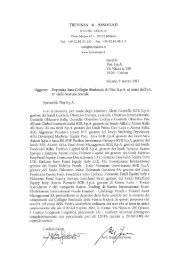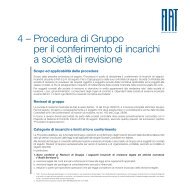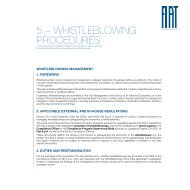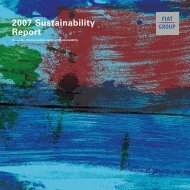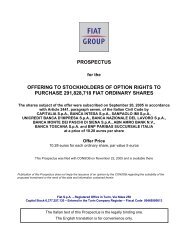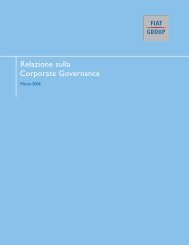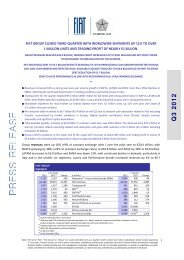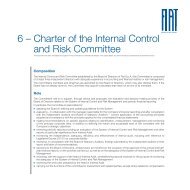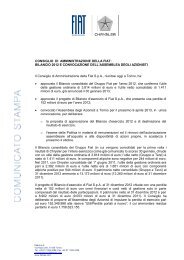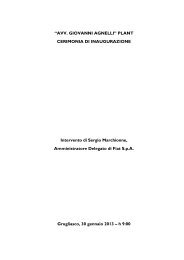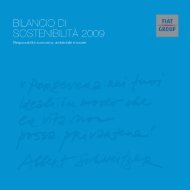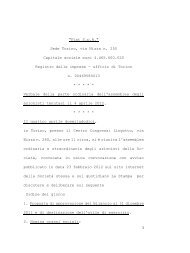2006 Annual Report - Fiat SpA
2006 Annual Report - Fiat SpA
2006 Annual Report - Fiat SpA
Create successful ePaper yourself
Turn your PDF publications into a flip-book with our unique Google optimized e-Paper software.
components, engines, and production systems) are recognised<br />
as an asset if and only if all of the following conditions are<br />
met: the development costs can be measured reliably and the<br />
technical feasibility of the product, volumes and pricing<br />
support the view that the development expenditure will<br />
generate future economic benefits. Capitalised development<br />
costs comprise only expenditures that can be attributed<br />
directly to the development process.<br />
Capitalised development costs are amortised on a systematic<br />
basis from the start of production of the related product over<br />
the product‘s estimated life, as follows:<br />
N° of years<br />
Cars 4 - 5<br />
Trucks and buses 8<br />
Agricultural and construction equipment 5<br />
Engines 8 - 10<br />
Components and Production Systems 3 - 5<br />
All other development costs are expensed as incurred.<br />
Intangible assets with indefinite useful lives<br />
Intangible assets with indefinite useful lives consist principally<br />
of acquired trademarks which have no legal, regulatory,<br />
contractual, competitive, economic, or other factors that limits<br />
their useful lives. Intangible assets with indefinite useful lives<br />
are not amortised, but are tested for impairment annually or<br />
more frequently whenever there is an indication that the asset<br />
may be impaired.<br />
Other intangible assets<br />
Other purchased and internally-generated intangible assets<br />
are recognised as assets in accordance with IAS 38 – Intangible<br />
Assets, where it is probable that the use of the asset will<br />
generate future economic benefits and where the costs of<br />
the asset can be determined reliably.<br />
Such assets are measured at purchase or manufacturing cost<br />
and amortised on a straight-line basis over their estimated<br />
useful lives, if these assets have finite useful lives.<br />
96 <strong>Fiat</strong> Group Consolidated Financial Statements at December 31, <strong>2006</strong> - Notes<br />
Other intangible assets acquired as part of an acquisition<br />
of a business are capitalised separately from goodwill if their<br />
fair value can be measured reliably.<br />
Property, plant and equipment<br />
Cost<br />
Property, plant and equipment are stated at acquisition<br />
or production cost and are not revalued.<br />
Subsequent expenditures and the cost of replacing parts of an<br />
asset are capitalised only if they increase the future economic<br />
benefits embodied in that asset. All other expenditures are<br />
expensed as incurred. When such replacement costs are<br />
capitalised, the carrying amount of the parts that are replaced<br />
is recognised in the income statement.<br />
Property, plant and equipment also include vehicles sold with<br />
a buy-back commitment, which are recognised according to the<br />
method described in the paragraph Revenue recognition if the<br />
buy-back agreement originates from the Trucks and<br />
Commercial Vehicles Sutor.<br />
Assets held under finance leases, which provide the Group<br />
with substantially all the risks and rewards of ownership, are<br />
recognised as assets of the Group at their fair value or, if<br />
lower, at the present value of the minimum lease payments.<br />
The corresponding liability to the lessor is included in the<br />
financial statement as a debt. The assets are depreciated by<br />
the method and at the rates indicated below.<br />
Leases where the lessor retains substantially all the risks and<br />
rewards of ownership of the assets are classified as operating<br />
leases. Operating lease expenditures are expensed on a<br />
straight-line basis over the lease terms.<br />
Depreciation<br />
Depreciation is calculated on a straight-line basis over the<br />
estimated useful life of the assets as follows:<br />
Depreciation rates<br />
Buildings 2% - 10%<br />
Plant and machinery 8% - 30%<br />
Industrial and commercial equipment 15% - 25%<br />
Other assets 10% - 33%<br />
Land is not depreciated.<br />
Leased assets<br />
Leased assets include vehicles leased to retail customers<br />
by the Group’s leasing companies under operating lease<br />
agreements. They are stated at cost and depreciated at annual<br />
rates of between 15% and 25%.<br />
Investment property<br />
Real estate and buildings held in order to obtain rental income<br />
are carried at cost less accumulated depreciation (charged at<br />
annual rates of between 2.5% to 5%) and impairment losses.<br />
Impairment of assets<br />
The Group reviews, at least annually, the recoverability of the<br />
carrying amount of intangible assets (including capitalised<br />
development costs) and tangible assets, in order to determine<br />
whether there is any indication that those assets have suffered<br />
an impairment loss. If indications of impairment are present,<br />
the carrying amount of the asset is reduced to its recoverable<br />
amount. An intangible asset with an indefinite useful life is<br />
tested for impairment annually or more frequently, whenever<br />
there is an indication that the asset may be impaired.<br />
Where it is not possible to estimate the recoverable amount<br />
of an individual asset, the Group estimates the recoverable<br />
amount of the cash-generating unit to which the asset belongs.<br />
The recoverable amount of an asset is the higher of fair value<br />
less disposal costs and its value in use. In assessing its value in<br />
use, the pre-tax estimated future cash flows are discounted to<br />
their present value using a pre-tax discount rate that reflects<br />
current market assessments of the time value of money and the<br />
risks specific to the asset. An impairment loss is recognised<br />
when the recoverable amount is lower than the carrying amount.<br />
Where an impairment loss on assets other than goodwill<br />
subsequently no longer exists or has decreased the carrying<br />
amount of the asset or cash-generating unit is increased to the<br />
revised estimate of its recoverable amount, but not in excess<br />
of the carrying amount that would have been recorded had no<br />
impairment loss been recognised. A reversal of an impairment<br />
loss is recognised in the income statement immediately.<br />
Financial instruments<br />
Presentation<br />
Financial instruments held by the Group are presented in the<br />
financial statements as described in the following paragraphs.<br />
Investments and other non-current financial assets comprise<br />
investments in non-consolidated companies and other noncurrent<br />
financial assets (held-to-maturity securities, noncurrent<br />
loans and receivables and other non-current availablefor-sale<br />
financial assets).<br />
Current financial assets include trade receivables, receivables<br />
from financing activities (retail financing, dealer financing,<br />
lease financing and other current loans to third parties),<br />
current securities, and other current financial assets (which<br />
include derivative financial instruments stated at fair value<br />
as assets), as well as cash and cash equivalents.<br />
In particular, Cash and cash equivalents include cash at banks,<br />
units in liquidity funds and other money market securities that<br />
are readily convertible into cash and are subject to an<br />
insignificant risk of changes in value. Current securities include<br />
short-term or marketable securities which represent temporary<br />
investments of available funds and do not satisfy the<br />
requirements for being classified as cash equivalents; current<br />
securities include both available-for-sale and held for trading<br />
securities.<br />
Financial liabilities refer to debt, which includes asset-backed<br />
financing, and other financial liabilities (which include<br />
derivative financial instruments stated at fair value as<br />
liabilities), trade payables and other payables.<br />
<strong>Fiat</strong> Group Consolidated Financial Statements at December 31, <strong>2006</strong> - Notes 97


